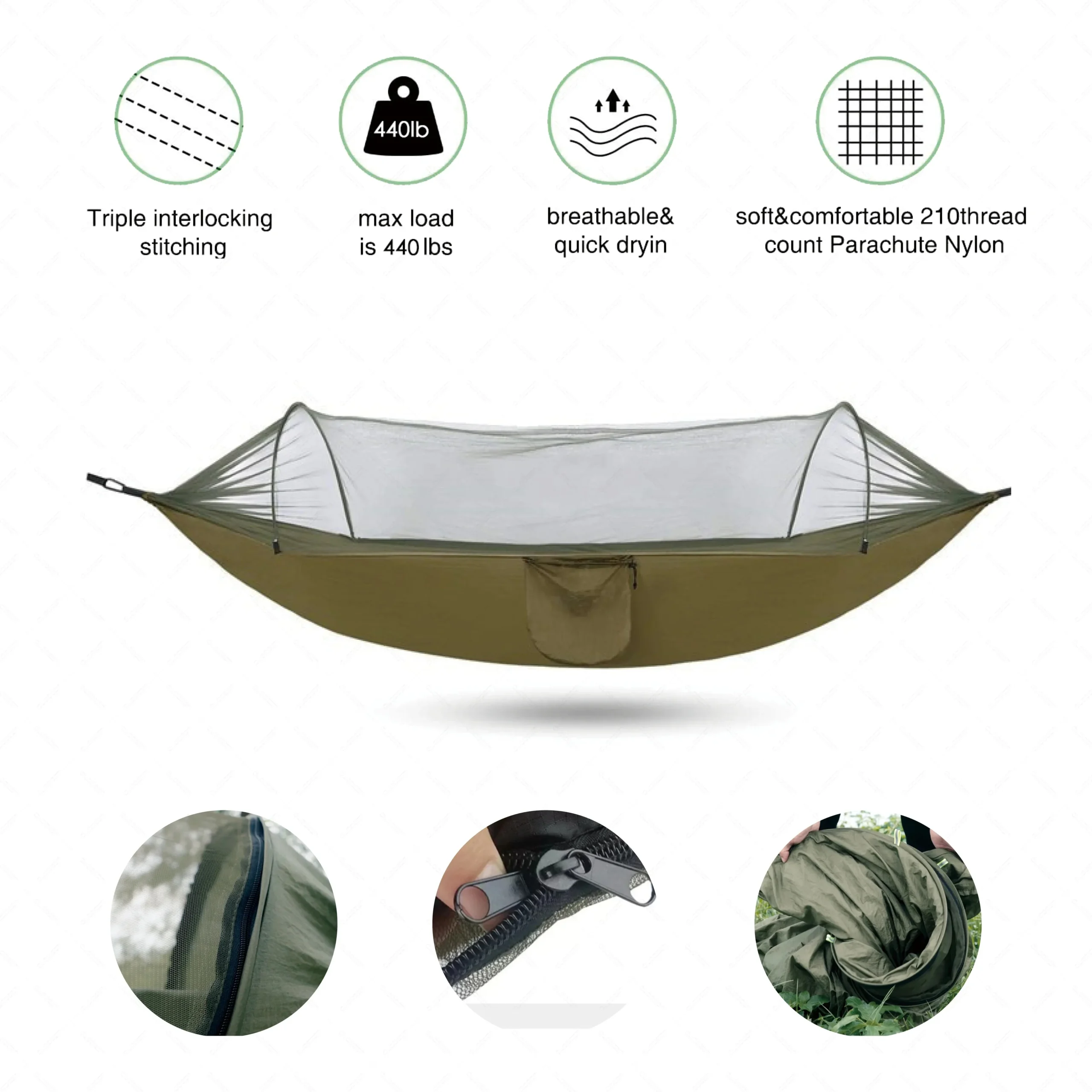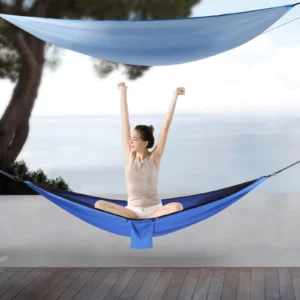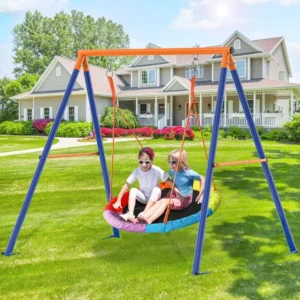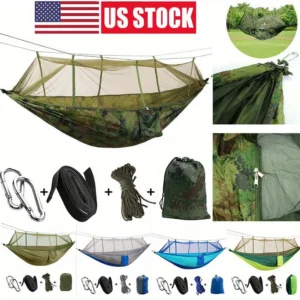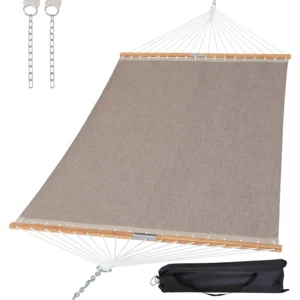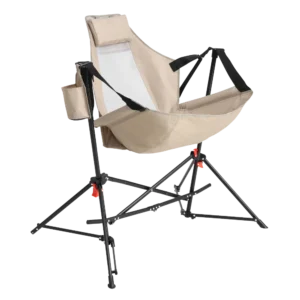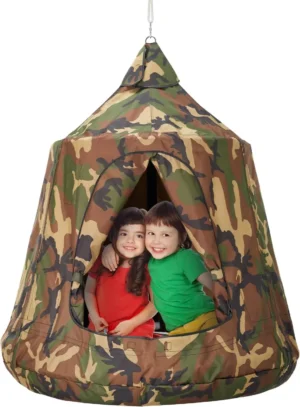Introduction: Why Every Ounce (and Inch) Matters on the Trail
When you’re miles from civilization with everything you need on your back, every ounce and every cubic inch of space becomes precious. This is where hammock packability enters the picture as a crucial consideration for hikers of all experience levels.
Packability refers to how efficiently gear can be compressed, carried, and stored while hiking. For hammock users, this means finding the perfect balance between:
- Minimal weight (reducing physical strain on long hikes)
- Compact dimensions (maximizing available pack space)
- Quick deployment and packing (saving time and energy on the trail)
- Adequate comfort and durability (ensuring restful sleep)
Did you know that the average backpacker’s load weighs between 15-40 pounds (7-18 kg)? A sleeping system typically accounts for 15-20% of that weight. By optimizing your hammock’s packability, you can significantly reduce your overall burden.
This guide will explore everything from key packability metrics to material considerations, packing techniques, and product recommendations to help you find the ideal lightweight hammock for your hiking adventures. Understanding the fundamentals of indoor outdoor hammock placement will provide additional context for making the best selection for your needs.
I. Understanding Hammock Packability: Essential Metrics for Hikers
Before diving into specific products and techniques, let’s establish the framework for evaluating hammock packability. Three core metrics determine how efficiently a hammock can be transported:
Weight
The most obvious measurement, typically expressed in ounces or grams. Every fraction of an ounce saved across multiple gear items can add up to significant weight reduction.
Packed Dimensions
The physical size (length × width × height) of the hammock when properly packed, usually measured in inches or centimeters.
Packed Volume
How much three-dimensional space the packed hammock occupies, often measured in liters or cubic inches.
Manufacturers sometimes emphasize one metric over others in their marketing, but as a hiker, you should consider all three. A hammock might be ultralight but bulky, or compact but heavy. The ideal combination depends on your specific hiking style and needs.
Understanding these fundamentals will help you better evaluate options and appreciate how certain ultralight hammock features contribute to overall packability.
A. The Weight Equation: Beyond Just Ounces
Hammock weight isn’t just about the total number on the scale. It’s about understanding the components that contribute to that weight and making informed choices about necessary trade-offs.
A typical hammock system has several weight components:
– Hammock body (the fabric you lie in): 7-16 oz (198-453 g)
– Suspension system (straps and hardware): 3-10 oz (85-283 g)
– Optional components (bug nets, ridgelines): 3-12 oz (85-340 g)
Fabric denier (a measure of fiber thickness) plays a crucial role in weight. For example:
– 1.0 oz (30D) nylon might weigh just 7 oz (198 g) for the hammock body
– 1.7 oz (70D) nylon provides more durability but might weigh 12 oz (340 g)
When evaluating hammocks for your hiking adventures, don’t forget that weight distribution in your pack matters as much as total weight. A well-distributed 2-pound (907 g) hammock system might feel better than a poorly packed 1.5-pound (680 g) system.
Our ultralight camping hammock sets provide excellent options that balance minimal weight with necessary durability for trail conditions.
B. Packed Size Dimensions: Visual Understanding
While weight affects how tired you’ll feel, packed size determines what else you can fit in your backpack. Understanding packed dimensions helps you visualize and plan your packing strategy.
Ultralight hammocks typically pack down to impressive dimensions:
– Small: 4” × 3” × 2” (10 × 8 × 5 cm) – About the size of a large apple
– Medium: 6” × 4” × 3” (15 × 10 × 8 cm) – Similar to a 12 oz soda can
– Large: 8” × 5” × 4” (20 × 13 × 10 cm) – Comparable to a 1-liter water bottle
Your packing technique significantly impacts these dimensions. With practice, many hikers can reduce their hammock’s packed size by 20-30% through proper folding and compression techniques. Learning how to pack a hammock for hiking can make a significant difference in your overall pack efficiency.
Remember that consistent packing is crucial for multi-day hikes. A hammock that grows in size each time you repack it can disrupt your carefully arranged backpack system.
C. Materials Impact on Packability and Performance
The fabric technology behind lightweight hammocks directly influences both packability and performance. Here’s how different materials compare:
Standard Ripstop Nylon
– 40D (1.9 oz/yd²): Good durability, moderate packability, affordable
– 20D (1.4 oz/yd²): Reduced weight, improved packability, still reasonably durable
– 10D (1.0 oz/yd²): Extremely packable, requires careful handling
Dyneema Composite Fabric (DCF)
– Incredibly lightweight (often 0.5-0.8 oz/yd²)
– Outstanding strength-to-weight ratio
– Exceptional water resistance
– Minimal stretch under load
– Very expensive compared to nylon options
– Less breathable than woven fabrics
Specialized Hybrid Fabrics
– Combine nylon with reinforcement threads
– Balance weight reduction with acceptable durability
– Often offer better packability than standard nylon
– Mid-range price point
The right material choice depends on your hiking priorities. Thru-hikers often prioritize weight and packability over durability and comfort, while weekend backpackers might prefer slightly heavier materials for improved durability and comfort.
For more information on longevity considerations, exploring fabric hammock durability will provide valuable insights for making an informed decision.
II. Practical Packing Techniques for Trail Efficiency
Even the most ultralight hammock won’t serve you well if you can’t pack it efficiently on the trail. Let’s explore techniques that maximize packability while protecting your gear.
Stuffing vs. Folding
– Stuffing (randomly compressing fabric into a sack): Quick, prevents crease wear, works well for synthetic materials
– Folding (creating neat layers): Better space optimization, easier to compress evenly, preferred for silnylon and DCF hammocks
Most experienced hammockers use a hybrid approach:
1. Loosely fold the hammock lengthwise once or twice
2. Stuff the folded hammock into its sack
3. Compress evenly from bottom to top
For wet conditions, remember that damp hammocks can expand by up to 30% in packed volume. Always pack wet gear in waterproof compartments separate from dry items. Quick-drying fabrics become especially valuable in wet environments.
Practicing these techniques at home can reduce your average pack-up time from 5+ minutes to under 2 minutes – a significant advantage when breaking camp in adverse conditions. For detailed guidance on efficient techniques, explore our guide on mastering pack efficiently pack hammock methods.

A. Integrating Your Hammock System in Your Backpack
Where and how you place your hammock within your backpack affects both comfort and convenience. Consider these strategic approaches:
Top Loading Backpacks
– Quick access: Upper compartment for frequent setup/takedown
– Weight distribution: Mid-section against your back for optimal carrying comfort
– Protection: Center of pack surrounded by softer items
Side/Bottom Access Backpacks
– Dedicated hammock compartment: Often at the bottom for stability
– Side pocket option: Good for hammocks you’ll set up at rest stops
For optimal efficiency, consider these packing strategies:
1. Pack suspension separately from the hammock for better space utilization
2. Use the hammock’s stuff sack as a pillow at night
3. Keep frequently accessed items (like tarps) in more accessible locations than the hammock itself
Many hikers develop a “quick-deploy” strategy, packing their hammock system so the components come out in the exact order needed for setup. This approach is especially valuable when setting up camp in rain or darkness.
For hammock systems that include bug protection, our camping hammock sets with bug net provide integrated solutions that pack efficiently without sacrificing protection.
III. Top Ultralight Hammocks: Packability Performance Analysis
| Model Type | Typical Weight | Packed Dimensions | Material | Capacity | Packability Efficiency |
|---|---|---|---|---|---|
| Minimalist Single | 5-8 oz (142-227 g) | 4” × 3” × 2” | 10D-20D Nylon | 250-300 lbs | Excellent |
| Standard Single | 9-16 oz (255-454 g) | 6” × 4” × 3” | 20D-40D Nylon | 300-400 lbs | Good |
| Integrated Bug Net | 16-24 oz (454-680 g) | 8” × 5” × 4” | 20D-40D Nylon | 250-350 lbs | Moderate |
| Asymmetric Design | 12-18 oz (340-510 g) | 7” × 4” × 3” | 20D-30D Nylon | 275-350 lbs | Good |
| Dyneema/DCF | 4-7 oz (113-198 g) | 4” × 3” × 2” | DCF | 250-300 lbs | Excellent |
When evaluating these options, consider the volume-to-weight ratio (packability efficiency). Ultralight hammocks typically excel in this metric, offering exceptional space savings relative to their already minimal weight.
The price-to-packability relationship generally follows a curve of diminishing returns. The jump from a standard hammock (16 oz/454 g) to a lightweight option (10 oz/283 g) often comes with a modest price increase of 30-50%. However, shaving those final few ounces to reach ultralight territory (5-7 oz/142-198 g) might double or triple the price.
For a variety of high-quality options that balance weight, packability, and value, our lightweight hammock sets offer excellent choices for hikers of all experience levels.
A. Minimalist Single-Layer Designs: Ultimate Packability
Single-layer hammock designs represent the pinnacle of packability for hikers obsessed with minimizing weight and bulk. These systems typically feature:
- Simplified construction with minimal seams
- Absence of integrated features (bug nets, storage pockets)
- High-performance, lightweight fabrics (often 10D-20D nylon)
- Minimalist suspension systems (thin dyneema cords, titanium hardware)
The packability benefits are substantial. A premium single-layer hammock can compress to the size of a large apple while weighing less than a small smartphone (5-7 oz/142-198 g). However, these extreme benefits come with considerations:
- Weight limits typically reduced to 250-300 lbs (113-136 kg)
- Increased vulnerability to abrasion and punctures
- Less forgiving setup requirements (precise tensioning needed)
- Potential comfort sacrifices for some sleepers
Fabric innovations have dramatically improved this category. Modern ultralight fabrics maintain surprising strength despite their minimal weight. Many thru-hikers report completing entire 2,000+ mile trails on a single ultralight hammock without failure.
Learning to elevate sleep lightweight hammock camping techniques can help maximize comfort even with minimalist designs.
B. Integrated Bug Protection: Balancing Features and Packability
Bug protection becomes essential in many hiking environments, but how does it affect packability? There are two main approaches:
1. Integrated Bug Net Systems
– Bug net permanently attached to the hammock
– Typically adds 5-8 oz (142-227 g) to total weight
– Increases packed size by approximately 25-40%
– Eliminates need for separate bug protection
– Offers convenient deployment and consistent protection
2. Modular Bug Net Systems
– Separate, detachable bug nets
– Can be left behind when not needed
– Adds complexity to setup/takedown
– Requires additional storage space when carried
– May offer more versatile positioning options
The packability difference is notable. A hammock with an integrated bug net typically packs to about the size of a 1-liter water bottle, while a standard hammock without bug protection might compress to the size of a soda can.
Special packing techniques can minimize this difference:
1. Fold the bug netting first, creating a flat base layer
2. Roll the hammock body around this base
3. Compress from multiple angles before final stuffing
For hikers seeking the best balance between protection and packability, our complete camping hammock systems offer thoughtfully designed solutions that integrate bug protection while maintaining reasonable packed dimensions.
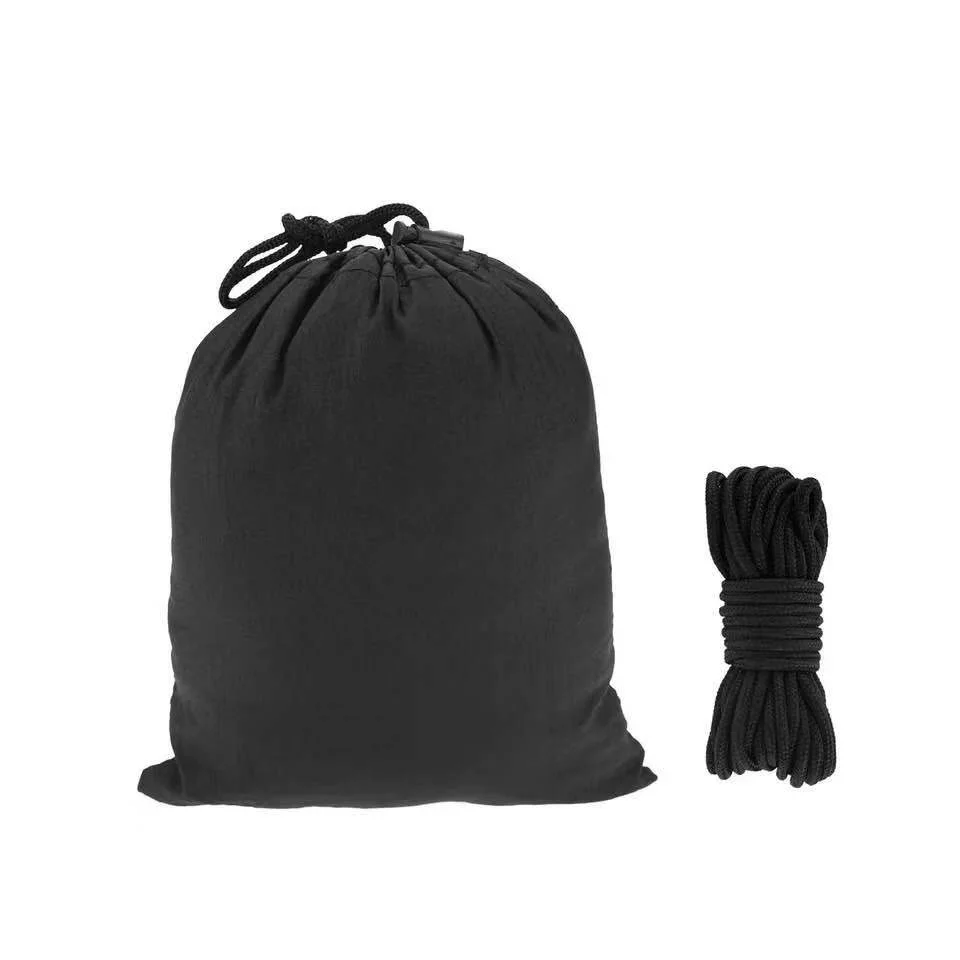
IV. The Complete System: Beyond Just the Hammock
When evaluating packability, experienced hikers consider the entire sleep system, not just the hammock itself. Here’s how a complete ultralight hammock system typically breaks down:
- Hammock body: 40-50% of total weight and volume
- Suspension system: 15-25% of total weight and volume
- Tarp/rain protection: 20-30% of total weight and volume
- Insulation (if needed): 10-30% of total weight and volume
This holistic view reveals why focusing solely on hammock weight can be misleading. A true ultralight system requires optimization across all components.
For tarps, the difference between a standard polyester tarp (16 oz/454 g) and an ultralight silnylon or DCF tarp (7-10 oz/198-283 g) can be more impactful than hammock material choices. Similarly, switching from standard webbing suspensions to lightweight options like Dyneema whoopie slings can save 4-6 oz (113-170 g) with minimal packed size increase.
Insulation presents special packability challenges. Underquilts and topquilts offer excellent thermal efficiency but significantly increase packed volume. Some ultralight hikers opt for closed-cell foam pads that can be stored flat against the back panel of their pack.
For guidance on assembling and configuring these components, our ultralight hammock setup guide provides valuable insights for creating an efficient system.
A. Ultralight Suspension Systems: Weight Reduction Strategies
The suspension system connecting your hammock to trees represents a significant optimization opportunity for weight-conscious hikers. Consider these options:
Traditional Webbing Suspensions
– Weight: 8-10 oz (227-283 g)
– Pros: Simple, durable, tree-friendly
– Cons: Heavier, bulkier when packed
Whoopie Slings
– Weight: 2-4 oz (57-113 g)
– Pros: Extremely light, infinitely adjustable
– Cons: Require more knowledge to use effectively
Lightweight Webbing + Toggle Systems
– Weight: 4-6 oz (113-170 g)
– Pros: Good balance of simplicity and weight savings
– Cons: Less adjustment range than whoopie slings
Ultra-Minimalist Dyneema Cord Systems
– Weight: 1-2 oz (28-57 g)
– Pros: Lightest option available, very compact
– Cons: Requires tree protection, less user-friendly
Hardware choices further impact weight and packability. Titanium components typically save 40-60% of weight compared to aluminum equivalents, while toggle systems can eliminate metal hardware entirely.
Your suspension selection should consider both your experience level and typical hiking conditions. For example, whoopie slings excel in environments where precise hang adjustments are needed, while webbing systems offer better versatility for unusual hanging situations.
For complete systems that include optimized suspension components, our camping hammocks stands collection offers excellent options for various hiking environments.
Camping Hammock Sets with Bug Net, Ultralight Camping Hammock Sets
$139.72 Select options This product has multiple variants. The options may be chosen on the product pageFolding Hammock Sets, Quick Setup Hammock Sets
Price range: $305.52 through $583.27 Select options This product has multiple variants. The options may be chosen on the product pageCamping Hammock Sets with Bug Net, Complete Camping Hammock Systems
Price range: $82.73 through $97.96 Select options This product has multiple variants. The options may be chosen on the product pageFolding Hammock Sets, Lightweight Hammock Sets
$295.80 Select options This product has multiple variants. The options may be chosen on the product pageComplete Camping Hammock Systems, Hanging Egg Chair Sets
$266.73 Select options This product has multiple variants. The options may be chosen on the product page
V. Balancing Packability with Comfort and Durability
While the pursuit of ultralight gear is admirable, it’s important to recognize the potential trade-offs. Finding your personal balance requires honest assessment of your needs.
The Comfort Equation
Extremely packable hammocks (under 8 oz/227 g) typically use thinner materials that provide less structure and stability. This can lead to a “cocoon effect” where the fabric wraps too tightly around the sleeper. Some ultralight hammocks also have reduced dimensions to save weight, which can limit sleeping positions.
Durability Considerations
Ultralight fabrics (10D-20D) may have only 30-50% of the tear and abrasion resistance of standard hammock fabrics (40D-70D). In practical terms, this means more careful site selection, gentler handling, and potentially shorter lifespan under heavy use.
Finding Your Balance
Consider these hiking styles and their typical packability priorities:
– Weekend warriors: Moderate weight (12-16 oz/340-454 g hammocks) balancing comfort and packability
– Section hikers: Lightweight options (8-12 oz/227-340 g) with selective feature integration
– Thru-hikers: Ultralight focus (5-8 oz/142-227 g) with careful attention to technique and site selection
The right choice depends on your personal comfort threshold, trip duration, and environmental conditions. For important safety information related to setup, our hammock installation requirements safety guide provides essential guidance.
A. Longevity Considerations: Protecting Your Investment
Proper care significantly extends the life of lightweight hammock systems, preserving both performance and packability over time.
Key practices include:
– Always store loosely at home, never compressed for extended periods
– Allow complete drying before long-term storage
– Protect from UV exposure when not in use
– Use appropriate tree protection to prevent abrasion during tensioning
– Clean with gentle, non-detergent methods
With proper care, the lifespan differences between hammock weight classes can be minimized:
– Ultralight hammocks (5-8 oz/142-227 g): Typically 1,000-2,000 miles of use
– Lightweight hammocks (9-16 oz/255-454 g): Often 2,000-5,000 miles
– Standard hammocks (16+ oz/454+ g): Potentially 5,000+ miles
For hikers concerned about durability in challenging environments, understanding whether it’s advisable to leave hammock outside in various conditions can help inform proper care decisions.
VI. Expert Insights: Field-Tested Packability Wisdom
Nothing replaces the wisdom gained from thousands of miles on trail. Here are key insights from experienced hammock hikers:
On Packing Technique
“I always practice my packing sequence at home before a big trip. What seems packable in your living room might feel very different when you’re tired and it’s getting dark. Develop a system and stick with it.” – Long-distance hiker with 4,000+ trail miles
On Material Selection
“The weight difference between my 20D and 10D hammocks is barely noticeable on my back, but the durability difference was significant. For most people, the slightly heavier option offers a better overall experience.” – Triple Crown thru-hiker
On System Integration
“I found that separating my hammock components into different stuff sacks actually hurt my packability. Everything compressed together takes up less total space than individually packed items.” – Ultralight backpacking instructor
Seasonal Considerations
“Summer hammocking is where you see the biggest packability advantage over tents. In winter, when you add underquilts and top insulation, the gap narrows considerably.” – Four-season hammock camper
For those prioritizing quick deployment on the trail, our collection of quick-setup hammock sets incorporates design features that simplify the process while maintaining excellent packability.
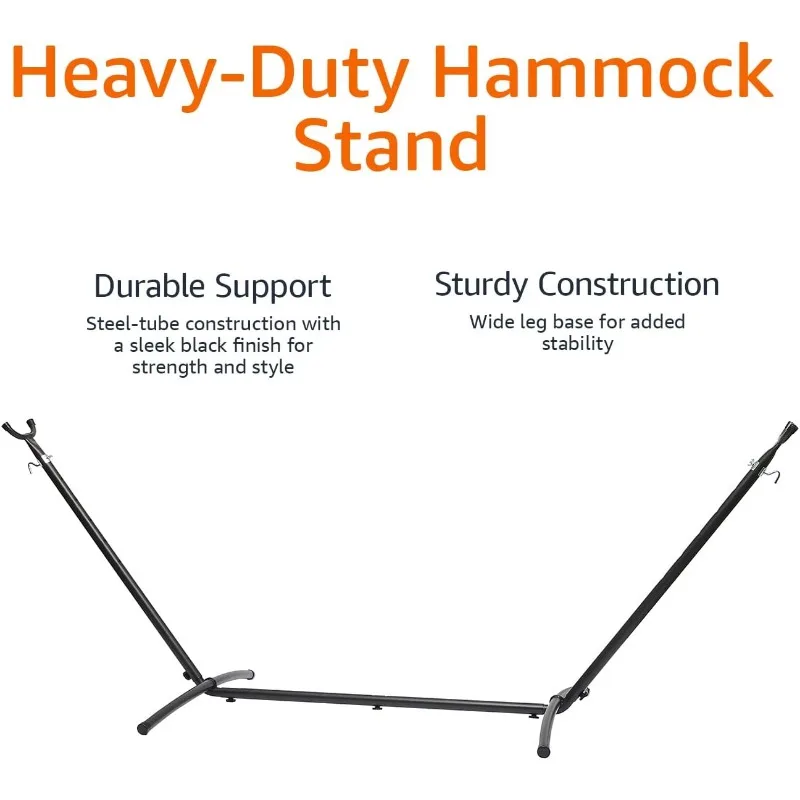
VII. Frequently Asked Questions About Hammock Packability
Is a stuff sack necessary for a packable hammock?
While not absolutely necessary, a proper stuff sack helps maintain consistent packed size and protects your hammock from snags and moisture. Most ultralight hikers use stuff sacks made from the same lightweight material as the hammock itself, adding only 0.2-0.5 oz (6-14 g) to the total weight.
How much does an ultralight hammock system typically weigh?
A complete ultralight hammock system (hammock, suspension, and tarp) typically weighs between 16-24 oz (454-680 g). Adding bug protection might increase this by 5-8 oz (142-227 g). This compares favorably to ultralight tent systems, which generally start around 32 oz (907 g) for comparable protection.
Can hammocks really pack down to the size claimed by manufacturers?
Yes, but achieving the advertised packed size usually requires proper technique and sometimes compression straps. Manufacturer claims typically represent optimal packing under controlled conditions. With practice, most users can achieve packed dimensions within 10-15% of advertised specifications.
How do different weather conditions affect hammock packability?
Humidity and moisture significantly impact packability. A wet hammock may expand in volume by 20-40% and gain 2-4 oz (57-113 g) in water weight. Synthetic materials like nylon tend to maintain better packability when wet compared to natural fibers, though they still experience some expansion.
Do ultralight hammocks sacrifice durability for packability?
There is a correlation between weight reduction and decreased durability, but modern materials have narrowed this gap. Most ultralight hammocks use high-tenacity fabrics that offer surprising strength despite their minimal weight. The primary durability concern isn’t catastrophic failure but rather accelerated wear and reduced resistance to abrasion and punctures.
VIII. Making the Right Packability Choice for Your Adventure
Selecting the ideal hammock packability for your needs requires honest self-assessment:
Evaluate your hiking style:
– Day hiker: Comfort may outweigh packability concerns
– Weekend backpacker: Balance of features and packability
– Long-distance hiker: Prioritize weight and packed volumeConsider your environmental conditions:
– Dense forests: Smaller packed size helps navigate tight trails
– Alpine environments: Weight matters more on steep terrain
– Bug-heavy regions: Integrated protection might justify extra weightAccount for your physical capabilities:
– Previous injuries might make weight savings more important
– Hand strength affects your ability to compress gear tightlyBudget realistically:
– Entry-level lightweight options: $60-100
– Mid-range packable systems: $100-200
– Premium ultralight setups: $200-350+
Many hikers find that gradually transitioning to lighter gear allows them to discover their personal comfort threshold. Starting with moderately lightweight options and progressively testing lighter systems helps avoid costly mistakes.
For versatile options that offer excellent packability while maintaining comfort, our collection of folding hammock designs provides innovative solutions for various outdoor adventures.
Remember that the best hammock system is the one that encourages you to get outside more often. At Outside Luxe, we believe that finding the perfect balance between packability, comfort, and durability leads to more enjoyable adventures and lasting memories on the trail.

